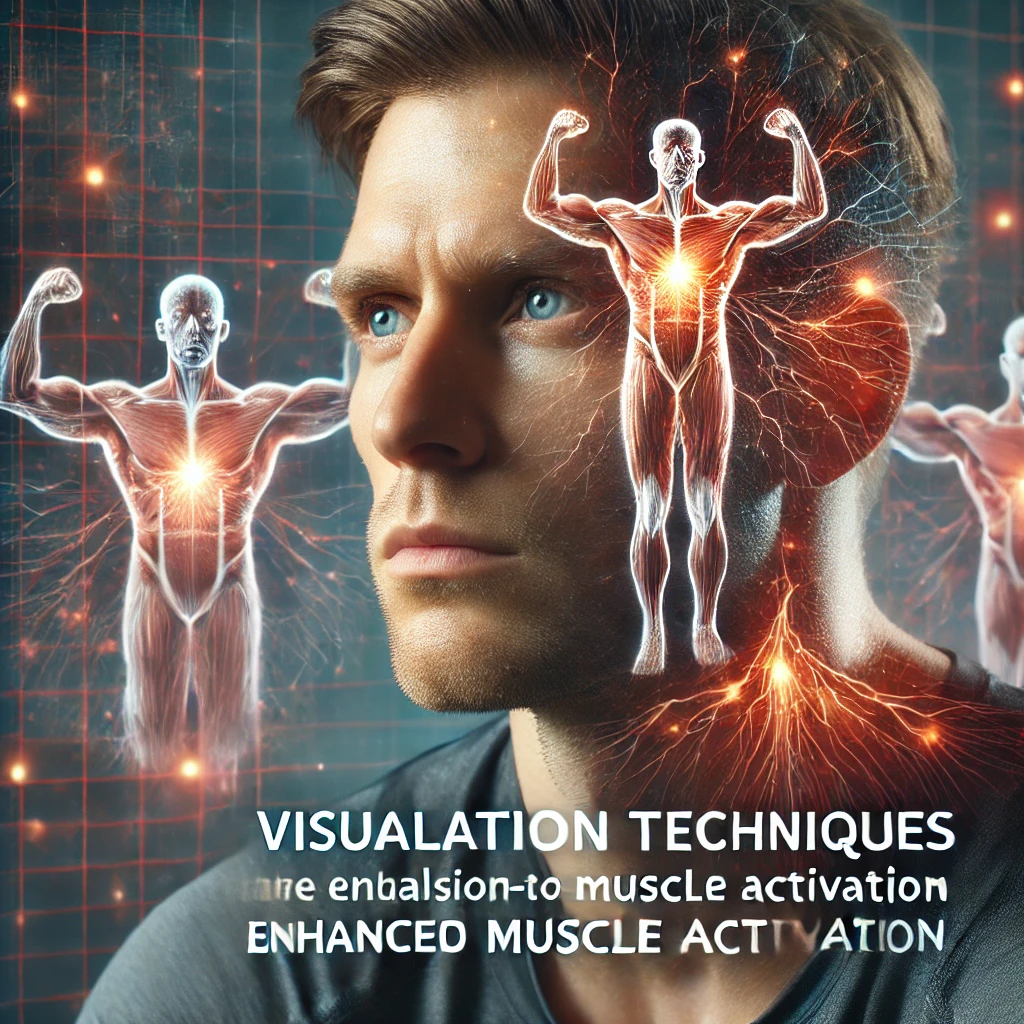Have you ever wondered why some people seem to get more out of their workouts, even though they’re lifting lighter weights? The secret might lie not in how much they lift, but in how well they’re engaging their muscles. This process is known as the mind to muscle connection, a powerful technique that can boost your strength, hypertrophy, and can enhance muscle activation.
When I first started lifting, I was more focused on chasing the numbers and lifting heavier weights than truly feeling the muscles work. As a result, my progress was slower than it should have been. Once I embraced the mind to muscle connection, not only did my results accelerate, but I began to feel my workouts at a deeper, more rewarding level.
Studies show that focusing on your muscles during exercise can boost activation by up to 22%! This means you can activate your muscles more effectively just by shifting your attention. I wish that I’d focused on this technique more and left my ego at the door during my early training mistake years.
In this article, we’ll explore how to harness the mind to muscle connection and enhance muscle activation to supercharge your gains. Let’s dive into the science, techniques, and personal insights that will transform the way you approach training.
FAQs About the Mind to Muscle Connection
1. What is the mind to muscle connection?
It’s the practice of consciously focusing on the muscles you’re working during exercise. By doing so, you increase muscle fibre recruitment and neural drive, leading to better muscle activation and faster results.
2. Does the mind to muscle connection really work?
Yes! Studies have shown that focusing on your muscles during exercise can boost activation by up to 22%, enhancing hypertrophy and strength gains over time.
3. How can I improve my mind to muscle connection?
Use techniques like:
- Tempo training: Slow down reps to increase time under tension.
- Visualisation: Picture the muscle contracting and relaxing during each rep.
- Isometric holds: Pause at peak contraction to focus on muscle engagement.
4. Why is the mind to muscle connection important for isolation exercises?
Isolation exercises target specific muscles. Without the mind to muscle connection, other muscles may take over, reducing the effectiveness of your workout and slowing progress.
5. How do pre-activation exercises help?
Pre-activation exercises “wake up” your muscles before heavier lifts, priming neural pathways and increasing focus during your workout. For example, glute bridges before deadlifts or light dumbbell raises before shoulder presses.
6. What are common mistakes when trying to enhance muscle activation?
- Lifting too heavy, which shifts focus away from the target muscle.
- Rushing reps, reducing time under tension.
- Neglecting a full range of motion, which limits muscle engagement.
7. Can lighter weights still be effective with the mind to muscle connection?
Absolutely. When you focus on proper form and muscle activation, even lighter weights can deliver significant results, improving strength and hypertrophy.
8. How do visualisation techniques work during workouts?
By imagining your muscles contracting and expanding, you enhance focus and muscle recruitment. Techniques like the “sponge method” (squeezing out and refilling tension) help improve engagement and performance.
By mastering the mind to muscle connection, you’ll unlock greater muscle activation and better results, even in shorter workouts.
Understanding the Mind to Muscle Connection
The mind to muscle connection is not just a fitness buzzword. At its core, it’s the practice of consciously focusing on the muscles you’re working during exercise. Instead of simply going through the motions, you zero in on contracting and engaging the specific muscles you want to target.
By doing this, you recruit more muscle fibres and increase neural drive, which helps you build muscle faster and more efficiently. If you’re looking to save time at the gym, you need to focus on intensity!
How It Works and helps to Enhance Muscle Activation
The mind to muscle connection relies heavily on your brain’s ability to communicate with your muscles through neural pathways. When you mentally focus on a specific muscle group, your brain sends stronger signals to that area, which increases muscle fibre recruitment. Here are three key aspects to understand:
- Neural Drive: By consciously focusing on a specific muscle, you increase the neural drive to that muscle, which means more motor units are recruited. This leads to greater muscle activation.
- Proprioception: Proprioception is your body’s ability to sense its position and movement in space. Enhancing this awareness through focused attention improves control over your target muscles.
- Muscle Fibre Recruitment: When you focus on engaging a muscle, you can potentially activate more muscle fibres. This leads to more effective workouts, better muscle growth, and an overall enhanced muscle activation.
Why It’s Important
The mind to muscle connection is particularly crucial for isolation exercises where the goal is to engage a specific muscle group. For compound exercises like squats and deadlifts, focusing on form and movement is essential, but even then, incorporating the mind to muscle connection can help improve muscle activation in key areas.
A study published in the Journal of Strength and Conditioning Research demonstrated that participants who focused on the muscles they were working during resistance training experienced significantly higher muscle activation. This means that focusing on muscle contractions can lead to better hypertrophy (muscle growth) compared to simply going through the motions.
Scientific Backing for the Mind to Muscle Connection

There’s no shortage of scientific research supporting the effectiveness of the mind to muscle connection. Studies have shown that mentally focusing on specific muscles during exercises can increase the activation of those muscles by a significant margin.
For instance, a study published in the European Journal of Applied Physiology revealed that participants who focused on their pectoral muscles during bench presses experienced an increase in muscle activity by 9% compared to those who didn’t focus on the target muscle. This may seem small, but over time, these small gains add up to more significant muscle growth.
Another study found that lifters who concentrated on their elbow flexors and quadriceps during exercises saw a marked increase in muscle thickness, a clear sign of hypertrophy. Internal focus—the ability to focus on a specific muscle—can lead to superior muscle development when compared to an external focus, such as paying attention to the movement of the weight.
The Role of Attention in Muscle Activation
What makes the mind to muscle connection particularly effective is that it forces you to slow down and pay attention to each rep. When you focus on each muscle contraction, you’re engaging the correct muscle groups rather than allowing other, non-target muscles to take over. This means more effective workouts, with more of the muscle activation going where it counts.
“The mind is everything. What you think, you become.” – Buddha
This famous quote applies to fitness as well. Your muscles respond to the mental cues you send them, so learning to focus on the mind to muscle connection will help you achieve faster results with less wasted effort.
Techniques to Enhance Muscle Activation
Now that we understand the theory behind the mind to muscle connection, let’s look at practical ways to improve it during your workouts. Each of these techniques is designed to help you feel every repetition more deeply, leading to better muscle activation.
Tempo Training: A Key to Mastering the Mind to Muscle Connection

Tempo training is a powerful way to improve your mind to muscle connection by controlling the speed of your movements. Slowing down your reps increases the time under tension, which gives you more time to focus on each phase of the lift—especially the eccentric (lowering) and concentric (lifting) phases.
How to Implement Tempo Training
When you lift too quickly, you risk letting momentum take over, which reduces muscle engagement. By slowing down, you can feel the muscle fibres working harder, improving muscle activation. Here’s a simple breakdown of how to use tempo training:
- Concentric Phase (Lifting): Take 3 seconds to lift the weight, focusing on the contracting muscle.
- Peak Contraction: Hold the top position for 1 second, squeezing the muscle as hard as possible.
- Eccentric Phase (Lowering): Take 3-4 seconds to lower the weight in a controlled manner, focusing on maintaining tension in the muscle.
- Rest at the Bottom: Pause briefly before starting the next rep to avoid using momentum.
Visualisation Techniques for Greater Muscle Activation

Visualisation is another powerful tool for enhancing your mind to muscle connection. By imagining your muscles contracting and expanding before and during an exercise, you can improve muscle recruitment and focus.
How to Implement Visualisation
Here are a few techniques that will help you visualise better during your workouts:
- Pre-set Visualisation: Before starting a set, spend 30 seconds imagining the target muscle working. Picture the muscle contracting during the lift and relaxing during the lowering phase.
- The Sponge Technique: Imagine your muscle as a sponge. During the concentric phase, picture yourself squeezing all the water out of the sponge. During the eccentric phase, imagine the sponge slowly refilling with water.
- The Light Bulb Method: Visualise your working muscle as a light bulb. As you contract, picture the bulb glowing brighter. As you relax, the light dims slightly but never fully turns off.
By using visualisation, you can increase focus and enhance muscle activation, leading to more efficient workouts and faster progress.
The Role of Isometric Holds in Developing Mind to Muscle Connection
Isometric holds are another excellent method for enhancing your mind to muscle connection. These are static contractions where the muscle remains at the same length while generating tension. This technique allows you to focus intensely on muscle engagement, particularly at the peak of the movement or at the point of maximum stretch.
How to Implement Isometric Holds
Isometric holds can be applied to nearly any exercise. They are particularly effective for exercises where the peak contraction is a key component of muscle engagement. Here’s how you can implement isometric holds into your workouts:
- Mid-Rep Holds: During a bicep curl, for example, you can pause halfway through the movement and hold the weight for 3-5 seconds, focusing on squeezing the bicep.
- Peak Contraction Holds: At the top of a chest press, hold the position for 10-15 seconds while maintaining maximum tension in the chest muscles.
- Loaded Stretches: In the bottom position of a squat, hold the stretch for 15-30 seconds, feeling the tension in your quadriceps and glutes.
Benefits of Isometric Holds
By holding a muscle under tension for an extended period, you enhance muscle activation and develop greater control over the muscle. Research has shown that isometric holds can recruit up to 95% of muscle fibres, compared to around 88% during regular dynamic movements. This makes isometric holds a powerful tool for improving strength and hypertrophy.
Isometric training also enhances proprioception, your body’s ability to sense its position in space. This increased awareness makes it easier to engage specific muscles in future workouts, improving overall performance.
Pre-Activation Warm-Ups for Muscle Engagement
A crucial but often overlooked step in developing the mind to muscle connection is the use of pre-activation warm-ups. Pre-activation involves performing light exercises that target the muscle group you plan to work on before diving into your main sets. This “primes” the muscles and neural pathways, making it easier to focus on the target muscle during your workout.
How to Implement Pre-Activation
Pre-activation exercises are typically light movements designed to stimulate the muscles you’ll be focusing on. For instance, before performing deadlifts, you might do a few sets of glute bridges to activate your glutes. Or, if you’re about to do shoulder presses, you can perform arm circles or light dumbbell raises to prime the shoulder muscles.
Examples of pre-activation exercises:
- Glute Bridges before deadlifts or squats.
- Arm Circles or Light Dumbbell Raises before shoulder presses.
- Hip Bridges or Lunges before performing leg-based exercises.
Why Pre-Activation Works
By engaging the target muscle with light, controlled movements, you prime the neural pathways that enhance the mind to muscle connection during the heavier lifts. Pre-activation increases blood flow to the muscles and “wakes them up,” helping you feel each rep more clearly when you start your main workout.
Studies have shown that pre-activation can significantly enhance muscle activation during compound lifts. For example, a study on agility training found that warming up the muscles increased their responsiveness during the main exercises. Incorporating pre-activation into your routine can give you an edge, especially for exercises where engaging the correct muscles is challenging.
Key Isolation Exercises for Enhanced Muscle Activation

While compound exercises are essential for building overall strength, isolation exercises allow you to focus on specific muscles and refine your mind to muscle connection. These exercises target individual muscle groups and are particularly effective for honing in on lagging muscles that may not get enough attention during compound movements.
Key Isolation Exercises and Techniques
Here are some key isolation exercises that you can incorporate into your training routine to enhance muscle activation:
Biceps: Dumbbell Curls
- Focus on a slow eccentric phase to increase time under tension. Use the Sponge Technique to visualise squeezing the bicep during the lift.
Triceps: Overhead Tricep Extensions
- Use a controlled tempo and visualise the triceps working during the extension and stretch phases.
Chest: Dumbbell Flyes
- This exercise is excellent for targeting the pectorals. Focus on squeezing at the top of the movement to maximise muscle activation.
Back: Straight-Arm Pulldowns
- A fantastic way to isolate the lats. Concentrate on pulling from the elbows rather than the hands to better engage the back muscles.
Shoulders: Lateral Raises
- Use lighter weights and a slow tempo to engage the deltoids. Visualise the shoulders lifting and lowering the weight in a controlled manner.
Quadriceps: Leg Extensions
- Focus on extending the legs slowly, pausing at the top for maximum contraction. Visualise the quads tightening as you lift the weight.
Hamstrings: Leg Curls
- Slow down the eccentric phase and picture your hamstrings working throughout the entire movement.
Calves: Standing Calf Raises
- Hold at the top of the movement and visualise the calf muscles contracting.
Techniques to Improve Muscle Activation in Isolation Exercises
When performing isolation exercises, there are several techniques you can use to further enhance your mind to muscle connection:
- Pre-Exhaust Technique: Perform an isolation exercise before a compound movement to fatigue the target muscle. For example, doing leg extensions before squats helps ensure your quadriceps are fully engaged during the squat.
- Unilateral Training: Focus on one side at a time (e.g., single-arm curls or single-leg squats) to improve the mind to muscle connection on each side.
- Isometric Holds: Incorporate pauses at the point of peak contraction to intensify the connection with the muscle.
- Slow Eccentric Phase: Lower the weight slowly (3-4 seconds) to increase time under tension and improve muscle awareness.
You’ll also want to check out my rest-pause article for some great muscle activation tips.
By incorporating these techniques into your isolation exercises, you’ll improve your ability to engage and focus on specific muscles, leading to better overall gains.
Common Mistakes to Avoid with the Mind to Muscle Connection

While mastering the mind to muscle connection can greatly improve your training, many people unknowingly make mistakes that limit their results. Here are some of the most common pitfalls, along with tips on how to avoid them:
1. Using Too Much Weight
One of the most common mistakes is focusing on lifting heavy weights rather than engaging the right muscles. When you lift too much weight, other muscle groups can take over, and the target muscles won’t be activated as effectively. This can slow down progress and increase your risk of injury.
- Solution: Focus on the mind to muscle connection by reducing the weight and increasing the time under tension. Concentrate on feeling the muscle work, rather than just moving the weight.
2. Neglecting the Full Range of Motion
Some lifters make the mistake of not using a full range of motion, which limits the effectiveness of the exercise and reduces muscle activation. For example, not going low enough in a squat or not fully extending during a bicep curl can reduce the engagement of the target muscle.
- Solution: Always aim for a full range of motion in every exercise. This ensures that the muscle is worked through its entire length, leading to better muscle development.
3. Rushing Through Reps
Speeding through your reps reduces the time your muscles spend under tension, which in turn reduces the overall activation of the muscle. Rushed reps can also lead to poor form and increase your chances of injury.
- Solution: Slow down your reps, particularly during the eccentric phase (the lowering part of the movement). By taking 3-4 seconds to lower the weight, you increase muscle activation and improve your mind to muscle connection.
4. Not Focusing Mentally
It’s easy to let your mind wander during a workout, especially if you’re distracted by your environment or thinking about other things. This takes away from your focus on the target muscles and can limit the effectiveness of your training.
- Solution: Be mindful and present during each rep. Use visualisation techniques and stay focused on the muscles you’re working. Eliminating distractions like phones or loud music can also help improve concentration.
How Well Do You Focus? (Quiz)
Before we dive into the final section, take this quick quiz to assess your focus during your workouts. How well do you engage your muscles, and are you maximising your results through the mind to muscle connection?
- Do you actively focus on the muscles you’re targeting during every exercise?
- Yes
- Sometimes
- Rarely
- Do you use slow, controlled movements during both the lifting and lowering phases of an exercise?
- Always
- Occasionally
- Never
- How often do you use visualisation techniques (mentally picturing the muscle working)?
- Every workout
- Sometimes
- I’ve never tried it
- Do you take your time to complete each rep, or do you rush through your sets?
- I take my time
- I sometimes rush
- I always rush
My Journey to Mastering the Mind to Muscle Connection
When I first started weightlifting, I made all the classic mistakes. Like many beginners, I was more focused on lifting heavy weights and chasing big numbers than engaging the muscles properly. As a result, I didn’t see the progress I had hoped for.
The turning point came when I met a seasoned trainer who introduced me to the concept of the mind to muscle connection. At first, I was sceptical. How could focusing on my muscles make such a big difference? But I decided to give it a try.
I started by reducing the weight I was lifting and focusing on feeling each muscle work during every rep. It was a humbling experience—exercises that once felt easy now became much harder as I engaged my muscles more intentionally. However, the results spoke for themselves. Within a few months, I saw improvements in both my strength and muscle definition. My muscles felt more responsive, and I had a much greater sense of control during my workouts.
One of the most important lessons I learned was that progress isn’t always about lifting the heaviest weights. By mastering the mind to muscle connection, I was able to get more out of each workout, even with lighter weights. The gains I made weren’t just physical—they were mental as well.
This experience taught me that developing a strong mind to muscle connection is the key to unlocking your full potential in the gym. It’s not about how much you lift, but how well you lift it. By focusing on your muscles and slowing down your reps, you can achieve greater muscle activation and faster progress.
Key Takeaways
- The mind to muscle connection is essential for maximising muscle activation and muscle growth.
- Techniques like tempo training, visualisation, and isometric holds can improve your ability to engage specific muscles.
- Pre-activation exercises prime your muscles for better performance during your main workout.
- Avoid common mistakes such as lifting too heavy, rushing reps, and neglecting the full range of motion.
- By focusing on muscle activation, you can achieve better results even with lighter weights.
Conclusion: Harnessing Your Mental Strength
Mastering the mind to muscle connection is about more than just physical strength—it’s about training your brain to communicate more effectively with your muscles. By using the techniques outlined in this article, you can dramatically improve your muscle engagement, leading to faster progress and better overall results.
Remember, building muscle isn’t just about how much weight you can lift. It’s about how well you can engage the right muscles. Take the time to slow down, focus, and feel each rep. This will not only enhance your workouts but also make them more rewarding and enjoyable.
By harnessing the power of your mind, you can unlock new levels of strength and fitness. So, next time you’re in the gym, remember to connect your mind to your muscles and watch your progress soar.
Chat soon,
Matt


6 thoughts on “How to Master the Mind to Muscle Connection and Enhance Muscle Activation”
Comments are closed.